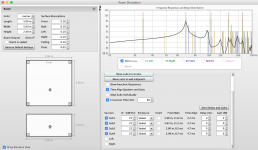Found a basic/stupid error in my use of REW room sim in the fact that I had previously ticked 'Align Subs Individually'
Predictions using four sealed subs look much better now, with a nice even response around the room if placed in corners. 4 subs provides a vastly improved response around the room compared to 3, 2 or worst 1. So the predictions now match the expectations.
What's with the SPL prediction in the frequency response graph though - 55dB? Do I have to calculate SPL output separately? I just want to make sure that 90dB at 30Hz upwards can be easily delivered.
Is there still any point considering dipole subs? Linkwitz provides comment here Frequently Asked Questions, but if I'm now predicted to achieve a nice even response using four subs I can't think of any benefits to dipole? If I was to go down the dipole sub route I'd be looking at a push-pull V-baffle like Linkwitz LX521 which would be similar expense. I did demo a pair of Linkwitz U-frame dipole subs and they sounded great, but reached xmax too soon so would need push-pull.
Nice idea with the bucket sub by the way!
"Time alignment (Align Subs Individually in REW) delays sub(s) to align the sound with the arrival time of sound from the furthest sub. In a rectangular room with subs placed symmetrically in the room time individual time alignment needs to be off (so all subs are producing the same signal at the same time) in order to obtain the cancellation of some modes that can produce."
Sub location based on Room Simulation | AV NIRVANA
Sub location based on Room Simulation | AV NIRVANA
Predictions using four sealed subs look much better now, with a nice even response around the room if placed in corners. 4 subs provides a vastly improved response around the room compared to 3, 2 or worst 1. So the predictions now match the expectations.
What's with the SPL prediction in the frequency response graph though - 55dB? Do I have to calculate SPL output separately? I just want to make sure that 90dB at 30Hz upwards can be easily delivered.
Is there still any point considering dipole subs? Linkwitz provides comment here Frequently Asked Questions, but if I'm now predicted to achieve a nice even response using four subs I can't think of any benefits to dipole? If I was to go down the dipole sub route I'd be looking at a push-pull V-baffle like Linkwitz LX521 which would be similar expense. I did demo a pair of Linkwitz U-frame dipole subs and they sounded great, but reached xmax too soon so would need push-pull.
Nice idea with the bucket sub by the way!
Attachments
Last edited:
Some other useful links I've come across:
Multiple dipole subs, can nulls be compensated and room response averaged out?
Multiple Small Subs - Geddes Approach
So one disadvantage of using multiple subs is that you need to cross using LR4, <100Hz otherwise localisation of the subs will occur (so no support in frequency response higher up for main speakers). they also need to be provided with mono source, so stereo dimension is lost.
There are also some interesting ideas on using a combination of using monopole sub(s) and then dipole to smooth the response, but no way to model this I believe.
Can anyone help me interpret the results found here - seems as though dipole subs are much better in the time domain?
Comparison of different near field and far field subwoofer configurations
Also, interesting concept from John, but I can't model this in REW?
DP_woofer_room
Multiple dipole subs, can nulls be compensated and room response averaged out?
Multiple Small Subs - Geddes Approach
So one disadvantage of using multiple subs is that you need to cross using LR4, <100Hz otherwise localisation of the subs will occur (so no support in frequency response higher up for main speakers). they also need to be provided with mono source, so stereo dimension is lost.
There are also some interesting ideas on using a combination of using monopole sub(s) and then dipole to smooth the response, but no way to model this I believe.
Can anyone help me interpret the results found here - seems as though dipole subs are much better in the time domain?
Comparison of different near field and far field subwoofer configurations
Also, interesting concept from John, but I can't model this in REW?
DP_woofer_room
Last edited:
- Status
- This old topic is closed. If you want to reopen this topic, contact a moderator using the "Report Post" button.
